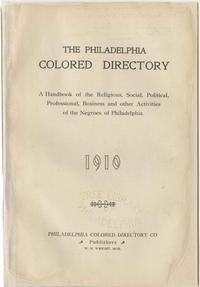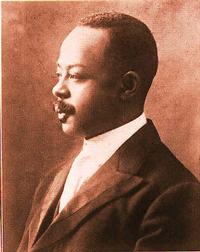The Philadelphia Colored Directory of 1910 Recently Scanned and Available for Download in Our Digital Collections
By Renee G.The Philadelphia Colored Directory, a handbook of religious, social, political, professional, business activities of the Negroes of Philadelphia, was compiled by R. (Richard) R. (Robert) Wright, Jr.; assisted by Ernest Smith. This archival resource, recentlly scanned and added to our Digital Collections (viewable online or as a downloadable pdf), provides a demographic analysis and glimpse of the way of life for the 62,613 African Americans living in Philadelphia during the early twentieth century.
Recorded are social and fraternal organizations, annotated lists of places of interest, and various learned professions; other sociological data gathered from the city’s census of 1900 are also presented in detail. The title also includes illustrated advertisements, lists of "books and pamphlets written by Philadelphia Negroes," "Interesting Facts about Philadelphia", "Interesting Facts about Negroes in Philadelphia", and names of individual patrolmen within the Police Bureau’s five districts; as well as lists of property holders, which was common to city directories of the time. Churches such as Enon, (Mother) Bethel, Zion Baptist and several others with existing congregations today are recorded in this directory. The time-frame of the directory is brief; however the scope of information is impressive. This valued source is helpful for family histories, genealogists, and historical researchers.
The title’s compiler, Richard Robert Wright, Jr. (1878-1967), was a bishop of the African Methodist Episcopal (A.M.E.) Church. He served as editor of the Christian Recorder, business manager of the A.M.E. Book Concern, and president of Wilberforce University. He is well known for his literary works in A.M.E. Church history and American sociology.
Richard R. Wright, Jr. received the first baccalaureate degree awarded by Georgia State Industrial College, now known as Savannah State University. He was the first African American to earn a Ph.D. from the University of Pennsylvania, having studied in the new field of sociology. He became a professor and later president of Wilberforce University in Ohio 1932-1936, and 1941-1942.
One of Richard Jr's daughters, Dr. Ruth Wright Hayre, also earned a Ph.D. at the University of Pennsylvania. They were the first African-American father and daughter to do so. Dr. Ruth Wright Hayre became the first full-time African-American teacher in the Philadelphia public school system. She served as a senior high school principal and as the first female president of the Philadelphia Board of Education. At the age of 80, she established the "Tell Them We Are Rising" program, promising to pay college tuition for 116 sixth-graders in two poor North Philadelphia schools if they completed high school. Her story was chronicled in her book Tell Them We Are Rising: A Memoir of Faith in Education, published in 1997, the year before she died.
Additional sources where the Philadelphia Colored Directory can be found:
- Hathi Trust Digital Library (Public domain, Google digitized)
- Historical Society of Pennsylvania – V. 1908, 1910, 1914
- The Philadelphia Colored Directory Google ebook (1907)
Related Resources
- Going North: An Oral History
A digital archive of more than 400 images, newspaper articles and other sources from national and regional collections.
- The Encyclopedia of Greater Philadelphia
A civic project to increase understanding of one of America’s greatest cities.
Have a question for Free Library staff? Please submit it to our Ask a Librarian page and receive a response within two business days.



